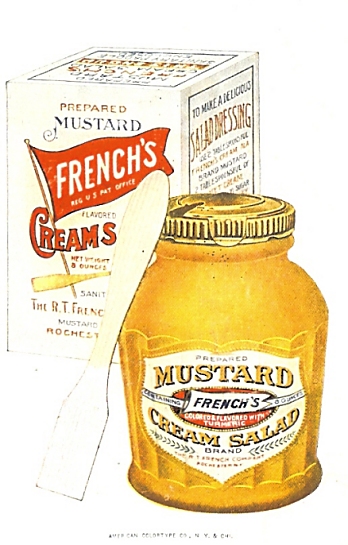Thursday, March 31, 2005
Page 15
REMINISCING (Column)
French’s Mustard Cleans Up Its Act, Revises Web Sites
By ROGER M. GRACE
This column on Dec. 9 began:
On the Internet, at www.frenchs.com, a timeline is presented. The entry for 1904 reads:
“French’s introduces its mustard with its sidekick the hot dog at the World’s Fair in St. Louis, MO.
At www.frenchsfoodservice.com, aimed at restaurants and the like, it’s declared:
“French’s Mustard was introduced at the 1904 World’s Fair in St. Louis helping to popularize a new culinary creation: the hot dog.”
This pretty much parallels the statement in a recent press release I quoted last week which represented:
“...French’s Cream Salad Mustard made it’s debut in 1904 at the St. Louis World’s Fair along with it’s side kick, the hot dog. Both were an instant success!”
As I pointed out then, and in subsequent columns, it wasn’t true. The hot dog was nothing new in 1904, and it’s doubtful that French’s mustard was applied to those sold at the 1904 world’s fair given that the French’s product was introduced there as a garnishment for salads. What’s more, hot dog vendors then mixed their own mustard from dry powder and liquids.
It’s gratifying to find that Reckitt Benckiser, the British company that owns the French’s product line, paid attention.
A couple of months ago, I didn’t think it had. I received a letter dated Jan. 17 from Elliott J. Penner, president of the U.S. subsidiary, saying that “I read your columns with interest,” and conveying information about the history of French’s mustard. However, he did not address my contentions as to the falsity of the company’s historical recitations, seemingly unconcerned.
I was therefore surprised to find when I took another look last week at the French’s websites, in readying to wind up this series of columns on mustard, that the malarky about French’s Mustard and the hot dog being introduced at the 1904 World’s Fair as a duo had been removed.
The timeline is gone from the website for consumers. And on the food service site, the entry for 1904 now reads simply:
“French’s Mustard debuts at the World’s Fair and takes its place as an American icon.”
It seems that French’s is starting to cut the mustard in terms of truth in advertising.
Here’s a portion of the letter from Penner:
As you know, mustard flavoring and pastes, of one form or another, have existed for thousands of years. Brown and spicy mustards have been served with meats and other foods for many generations. You correctly identify some of these commercialized spicy mustards in your columns. While you mention the English mustards, one must also give credit to the German and Chinese derivations. I can assure you, however, that French’s was the first cream-style mustard that Americans today identify as “yellow mustard” or often just simply as “mustard”. It was 1904 when Francis French shared the idea of a smooth, milder tasting mustard with his brother, George. Francis thought this new type of “prepared cream-style mustard” was more fitting with American tastes. While the R.T. French Company existed as a purveyor of spices long before they invented the Classic Yellow Mustard, it was this recipe that fueled the success of the company. It was because of the success of French’s Yellow Mustard that the company was able to survive the Great Depression, diversify, grow and prosper.
Now we are a part of a larger company, Reckitt Benckiser, but we retain the vision and passion that led French’s to create a mustard that many would grow to love.
While French’s Mustard is not the earliest of mustards still on the U.S. market (Gulden’s was first, followed by Heinz’s), French’s does appear to be the oldest U.S. brand of what was initially known as “cream salad” mustard.
|
|
|
Few would think nowadays of topping salads with mustard even if diluted, as prescribed in early days by French’s, with an equal amount of milk or cream, and perhaps with some sugar added. French’s now refers to its mustard as “Classic Yellow,” abandoning any association with salads.
The innovation of the R.T. French Company was the concocting of a prepared mustard that was mild enough that it would be palatable in a salad. While French’s “Cream Salad” mustard did happen to be yellow, the company did not invent yellow mustard. Turmeric, which causes the bright yellow color of the product, had long been used in mustard—being denounced by some in the late 1800s, when the purity of packaged foods was a hot issue, as an adulterant.
Recipes for mustard-based foods, such as chow-chow (mustard and relish), often included turmeric.
Copyright 2005, Metropolitan News Company
MetNews Main Page Reminiscing Columns
